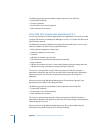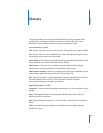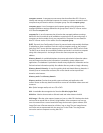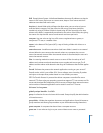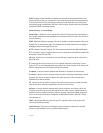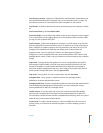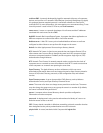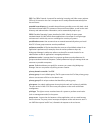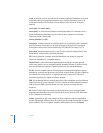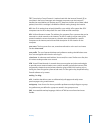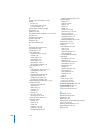
Glossary 263
POP Post Office Protocol. A protocol for retrieving incoming mail. After a user retrieves
POP mail, it’s stored on the user’s computer and is usually deleted automatically from
the mail server.
portable home directory A portable home directory provides a user with both a local
and network home folder. The contents of these two home folders, as well as the user's
directory and authentication information, can be automatically kept in sync.
POSIX Portable Operating System Interface for UNIX. A family of open system
standards based on UNIX, which allows applications to be written to a single target
environment in which they can run unchanged on a variety of systems.
predefined accounts User accounts that are created automatically when you install
Mac OS X. Some group accounts are also predefined.
preference manifest A file that describes the structure of and default values for an
application’s preferences (for example, what the various preference keys do).
Workgroup Manager’s preferences editor uses these files to make it easier for an
administrator to edit an application’s managed preferences.
preferences cache A storage place for computer preferences and preferences for
groups associated with that computer. Cached preferences help you manage local user
accounts on portable computers.
presets Default attributes you specify for accounts you create using Workgroup
Manager. You can use presets only during account creation.
primary domain controller See PDC.
primary group A user’s default group. The file system uses the ID of the primary group
when a user accesses a file he or she doesn’t own.
primary group ID A unique number that identifies a primary group.
print queue An orderly waiting area where print jobs wait until a printer is available.
The print service in Mac OS X Server uses print queues on the server to facilitate
management.
privileges The right to access restricted areas of a system or perform certain tasks
(such as management tasks) in the system.
proxy server A server that sits between a client application, such as a web browser,
and a real server. The proxy server intercepts all requests to the real server to see if it
can fulfill the requests itself. If not, it forwards the request to the real server.




